Health and Safety in Health and Social Care Workplace Legislation
VerifiedAdded on 2023/04/04
|15
|4641
|382
Report
AI Summary
This report provides a detailed analysis of health and safety legislations and their implementation in healthcare workplaces, focusing on the UK context. It reviews systems, procedures, and policies for effective communication of health and safety information, assesses stakeholder responsibilities, and discusses the practical application of safety legislations. The report also examines the impact of health and safety requirements on both customers and practitioners, analyzing risk assessment's role in care planning and the implications of non-compliance with safety regulations. Furthermore, it evaluates the monitoring and reviewing processes of health and safety practices, assessing their effectiveness in promoting a positive safety culture and contributing to overall healthcare quality, referencing the Mid Staffordshire NHS Foundation Trust as a case example. This document is available on Desklib, a platform offering various AI-based study tools and resources for students.
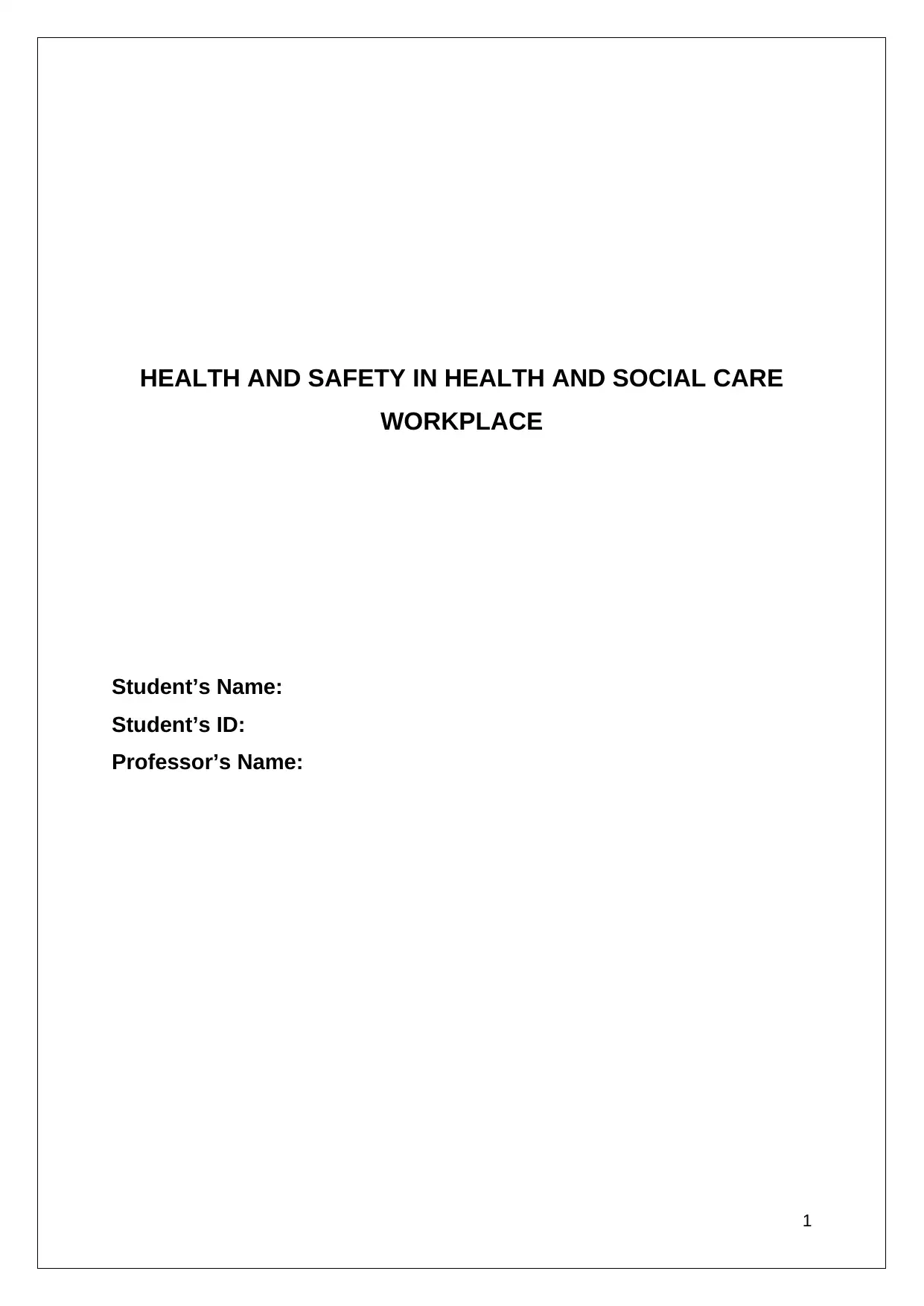
HEALTH AND SAFETY IN HEALTH AND SOCIAL CARE
WORKPLACE
Student’s Name:
Student’s ID:
Professor’s Name:
1
WORKPLACE
Student’s Name:
Student’s ID:
Professor’s Name:
1
Paraphrase This Document
Need a fresh take? Get an instant paraphrase of this document with our AI Paraphraser
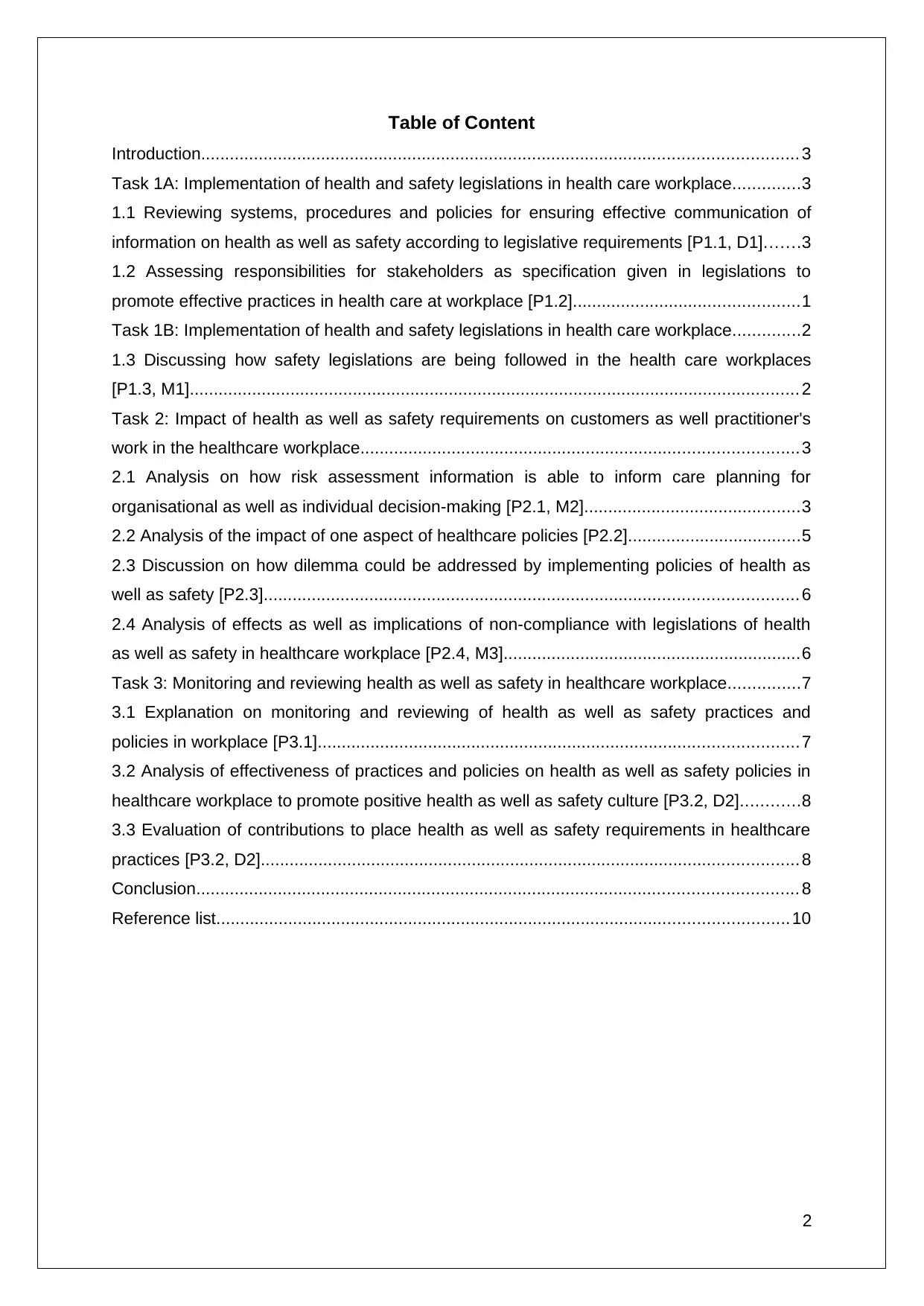
Table of Content
Introduction............................................................................................................................ 3
Task 1A: Implementation of health and safety legislations in health care workplace..............3
1.1 Reviewing systems, procedures and policies for ensuring effective communication of
information on health as well as safety according to legislative requirements [P1.1, D1].......3
1.2 Assessing responsibilities for stakeholders as specification given in legislations to
promote effective practices in health care at workplace [P1.2]...............................................1
Task 1B: Implementation of health and safety legislations in health care workplace..............2
1.3 Discussing how safety legislations are being followed in the health care workplaces
[P1.3, M1]............................................................................................................................... 2
Task 2: Impact of health as well as safety requirements on customers as well practitioner's
work in the healthcare workplace...........................................................................................3
2.1 Analysis on how risk assessment information is able to inform care planning for
organisational as well as individual decision-making [P2.1, M2].............................................3
2.2 Analysis of the impact of one aspect of healthcare policies [P2.2]....................................5
2.3 Discussion on how dilemma could be addressed by implementing policies of health as
well as safety [P2.3]............................................................................................................... 6
2.4 Analysis of effects as well as implications of non-compliance with legislations of health
as well as safety in healthcare workplace [P2.4, M3]..............................................................6
Task 3: Monitoring and reviewing health as well as safety in healthcare workplace...............7
3.1 Explanation on monitoring and reviewing of health as well as safety practices and
policies in workplace [P3.1]....................................................................................................7
3.2 Analysis of effectiveness of practices and policies on health as well as safety policies in
healthcare workplace to promote positive health as well as safety culture [P3.2, D2]............8
3.3 Evaluation of contributions to place health as well as safety requirements in healthcare
practices [P3.2, D2]................................................................................................................ 8
Conclusion............................................................................................................................. 8
Reference list....................................................................................................................... 10
2
Introduction............................................................................................................................ 3
Task 1A: Implementation of health and safety legislations in health care workplace..............3
1.1 Reviewing systems, procedures and policies for ensuring effective communication of
information on health as well as safety according to legislative requirements [P1.1, D1].......3
1.2 Assessing responsibilities for stakeholders as specification given in legislations to
promote effective practices in health care at workplace [P1.2]...............................................1
Task 1B: Implementation of health and safety legislations in health care workplace..............2
1.3 Discussing how safety legislations are being followed in the health care workplaces
[P1.3, M1]............................................................................................................................... 2
Task 2: Impact of health as well as safety requirements on customers as well practitioner's
work in the healthcare workplace...........................................................................................3
2.1 Analysis on how risk assessment information is able to inform care planning for
organisational as well as individual decision-making [P2.1, M2].............................................3
2.2 Analysis of the impact of one aspect of healthcare policies [P2.2]....................................5
2.3 Discussion on how dilemma could be addressed by implementing policies of health as
well as safety [P2.3]............................................................................................................... 6
2.4 Analysis of effects as well as implications of non-compliance with legislations of health
as well as safety in healthcare workplace [P2.4, M3]..............................................................6
Task 3: Monitoring and reviewing health as well as safety in healthcare workplace...............7
3.1 Explanation on monitoring and reviewing of health as well as safety practices and
policies in workplace [P3.1]....................................................................................................7
3.2 Analysis of effectiveness of practices and policies on health as well as safety policies in
healthcare workplace to promote positive health as well as safety culture [P3.2, D2]............8
3.3 Evaluation of contributions to place health as well as safety requirements in healthcare
practices [P3.2, D2]................................................................................................................ 8
Conclusion............................................................................................................................. 8
Reference list....................................................................................................................... 10
2
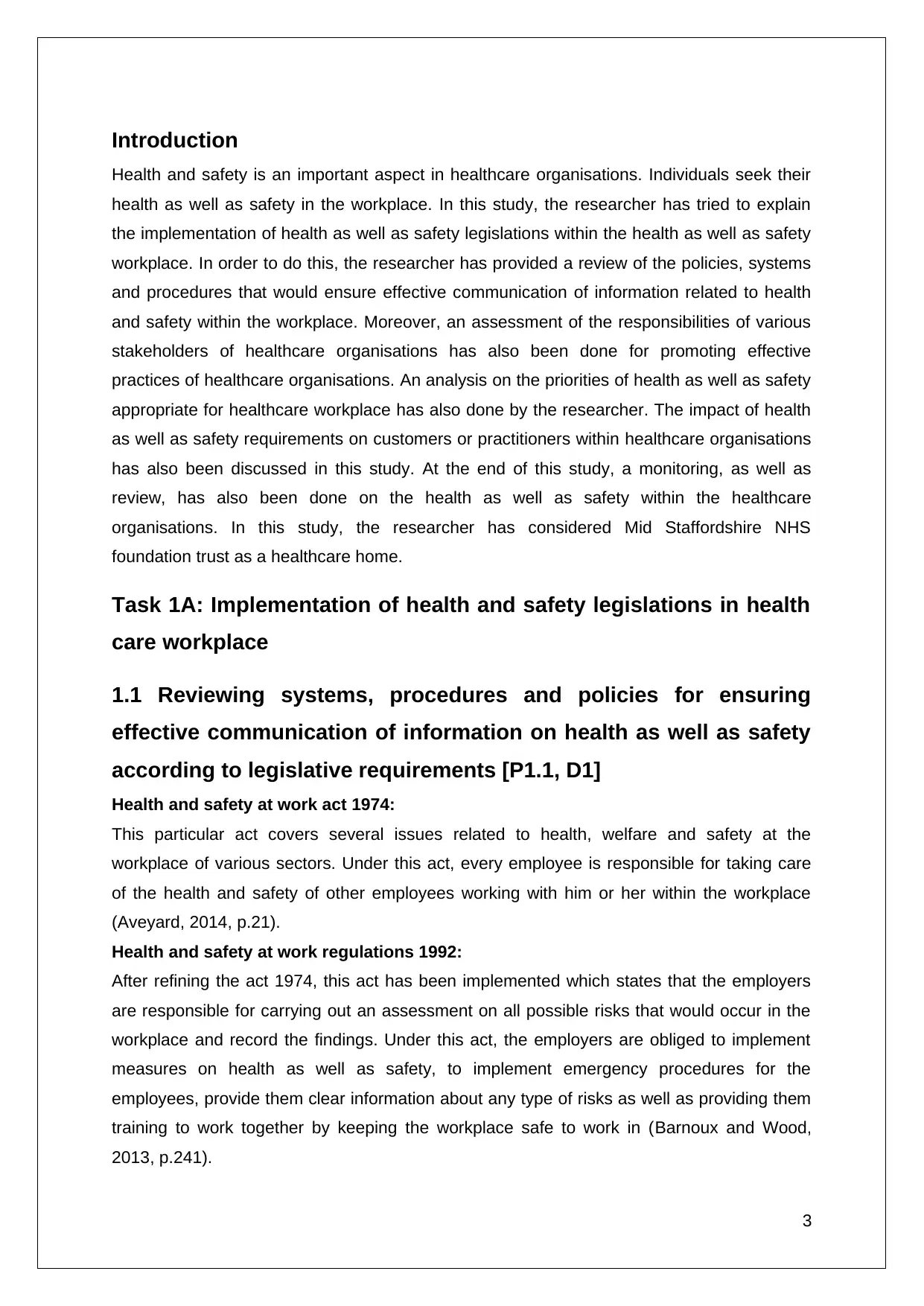
Introduction
Health and safety is an important aspect in healthcare organisations. Individuals seek their
health as well as safety in the workplace. In this study, the researcher has tried to explain
the implementation of health as well as safety legislations within the health as well as safety
workplace. In order to do this, the researcher has provided a review of the policies, systems
and procedures that would ensure effective communication of information related to health
and safety within the workplace. Moreover, an assessment of the responsibilities of various
stakeholders of healthcare organisations has also been done for promoting effective
practices of healthcare organisations. An analysis on the priorities of health as well as safety
appropriate for healthcare workplace has also done by the researcher. The impact of health
as well as safety requirements on customers or practitioners within healthcare organisations
has also been discussed in this study. At the end of this study, a monitoring, as well as
review, has also been done on the health as well as safety within the healthcare
organisations. In this study, the researcher has considered Mid Staffordshire NHS
foundation trust as a healthcare home.
Task 1A: Implementation of health and safety legislations in health
care workplace
1.1 Reviewing systems, procedures and policies for ensuring
effective communication of information on health as well as safety
according to legislative requirements [P1.1, D1]
Health and safety at work act 1974:
This particular act covers several issues related to health, welfare and safety at the
workplace of various sectors. Under this act, every employee is responsible for taking care
of the health and safety of other employees working with him or her within the workplace
(Aveyard, 2014, p.21).
Health and safety at work regulations 1992:
After refining the act 1974, this act has been implemented which states that the employers
are responsible for carrying out an assessment on all possible risks that would occur in the
workplace and record the findings. Under this act, the employers are obliged to implement
measures on health as well as safety, to implement emergency procedures for the
employees, provide them clear information about any type of risks as well as providing them
training to work together by keeping the workplace safe to work in (Barnoux and Wood,
2013, p.241).
3
Health and safety is an important aspect in healthcare organisations. Individuals seek their
health as well as safety in the workplace. In this study, the researcher has tried to explain
the implementation of health as well as safety legislations within the health as well as safety
workplace. In order to do this, the researcher has provided a review of the policies, systems
and procedures that would ensure effective communication of information related to health
and safety within the workplace. Moreover, an assessment of the responsibilities of various
stakeholders of healthcare organisations has also been done for promoting effective
practices of healthcare organisations. An analysis on the priorities of health as well as safety
appropriate for healthcare workplace has also done by the researcher. The impact of health
as well as safety requirements on customers or practitioners within healthcare organisations
has also been discussed in this study. At the end of this study, a monitoring, as well as
review, has also been done on the health as well as safety within the healthcare
organisations. In this study, the researcher has considered Mid Staffordshire NHS
foundation trust as a healthcare home.
Task 1A: Implementation of health and safety legislations in health
care workplace
1.1 Reviewing systems, procedures and policies for ensuring
effective communication of information on health as well as safety
according to legislative requirements [P1.1, D1]
Health and safety at work act 1974:
This particular act covers several issues related to health, welfare and safety at the
workplace of various sectors. Under this act, every employee is responsible for taking care
of the health and safety of other employees working with him or her within the workplace
(Aveyard, 2014, p.21).
Health and safety at work regulations 1992:
After refining the act 1974, this act has been implemented which states that the employers
are responsible for carrying out an assessment on all possible risks that would occur in the
workplace and record the findings. Under this act, the employers are obliged to implement
measures on health as well as safety, to implement emergency procedures for the
employees, provide them clear information about any type of risks as well as providing them
training to work together by keeping the workplace safe to work in (Barnoux and Wood,
2013, p.241).
3
⊘ This is a preview!⊘
Do you want full access?
Subscribe today to unlock all pages.

Trusted by 1+ million students worldwide
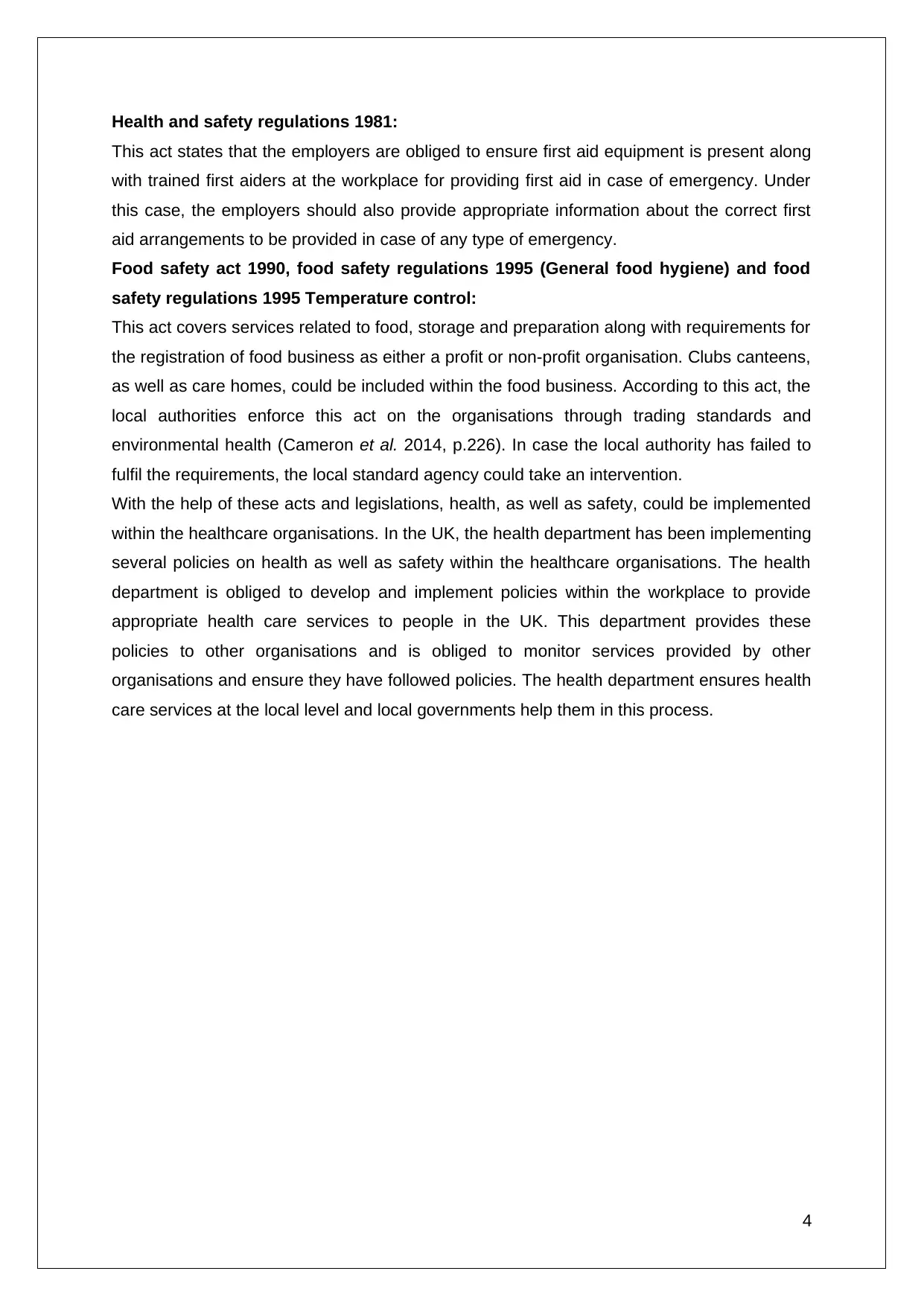
Health and safety regulations 1981:
This act states that the employers are obliged to ensure first aid equipment is present along
with trained first aiders at the workplace for providing first aid in case of emergency. Under
this case, the employers should also provide appropriate information about the correct first
aid arrangements to be provided in case of any type of emergency.
Food safety act 1990, food safety regulations 1995 (General food hygiene) and food
safety regulations 1995 Temperature control:
This act covers services related to food, storage and preparation along with requirements for
the registration of food business as either a profit or non-profit organisation. Clubs canteens,
as well as care homes, could be included within the food business. According to this act, the
local authorities enforce this act on the organisations through trading standards and
environmental health (Cameron et al. 2014, p.226). In case the local authority has failed to
fulfil the requirements, the local standard agency could take an intervention.
With the help of these acts and legislations, health, as well as safety, could be implemented
within the healthcare organisations. In the UK, the health department has been implementing
several policies on health as well as safety within the healthcare organisations. The health
department is obliged to develop and implement policies within the workplace to provide
appropriate health care services to people in the UK. This department provides these
policies to other organisations and is obliged to monitor services provided by other
organisations and ensure they have followed policies. The health department ensures health
care services at the local level and local governments help them in this process.
4
This act states that the employers are obliged to ensure first aid equipment is present along
with trained first aiders at the workplace for providing first aid in case of emergency. Under
this case, the employers should also provide appropriate information about the correct first
aid arrangements to be provided in case of any type of emergency.
Food safety act 1990, food safety regulations 1995 (General food hygiene) and food
safety regulations 1995 Temperature control:
This act covers services related to food, storage and preparation along with requirements for
the registration of food business as either a profit or non-profit organisation. Clubs canteens,
as well as care homes, could be included within the food business. According to this act, the
local authorities enforce this act on the organisations through trading standards and
environmental health (Cameron et al. 2014, p.226). In case the local authority has failed to
fulfil the requirements, the local standard agency could take an intervention.
With the help of these acts and legislations, health, as well as safety, could be implemented
within the healthcare organisations. In the UK, the health department has been implementing
several policies on health as well as safety within the healthcare organisations. The health
department is obliged to develop and implement policies within the workplace to provide
appropriate health care services to people in the UK. This department provides these
policies to other organisations and is obliged to monitor services provided by other
organisations and ensure they have followed policies. The health department ensures health
care services at the local level and local governments help them in this process.
4
Paraphrase This Document
Need a fresh take? Get an instant paraphrase of this document with our AI Paraphraser
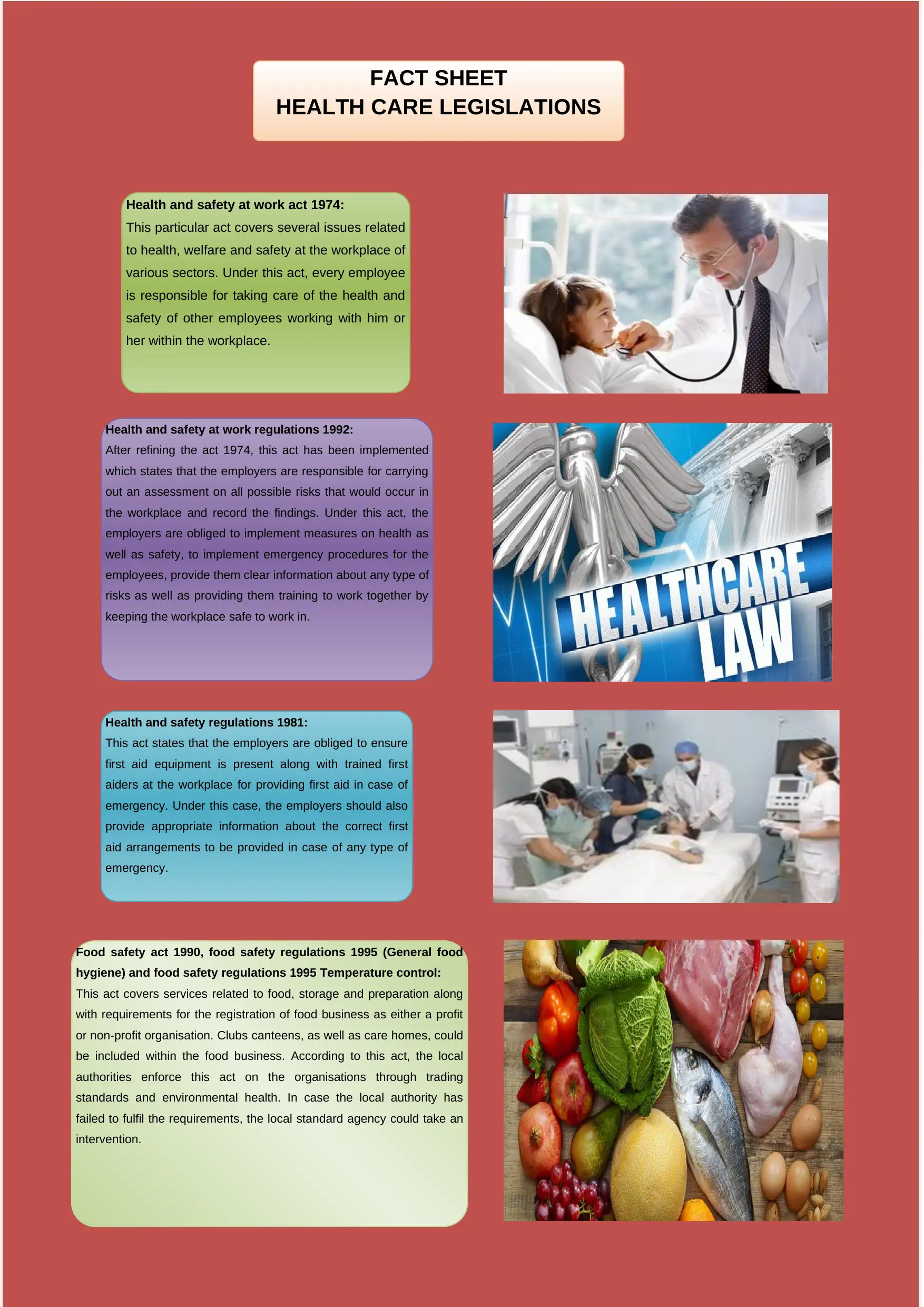
1
FACT SHEET
HEALTH CARE LEGISLATIONS
Health and safety at work act 1974:
This particular act covers several issues related
to health, welfare and safety at the workplace of
various sectors. Under this act, every employee
is responsible for taking care of the health and
safety of other employees working with him or
her within the workplace.
Health and safety at work regulations 1992:
After refining the act 1974, this act has been implemented
which states that the employers are responsible for carrying
out an assessment on all possible risks that would occur in
the workplace and record the findings. Under this act, the
employers are obliged to implement measures on health as
well as safety, to implement emergency procedures for the
employees, provide them clear information about any type of
risks as well as providing them training to work together by
keeping the workplace safe to work in.
Health and safety regulations 1981:
This act states that the employers are obliged to ensure
first aid equipment is present along with trained first
aiders at the workplace for providing first aid in case of
emergency. Under this case, the employers should also
provide appropriate information about the correct first
aid arrangements to be provided in case of any type of
emergency.
Food safety act 1990, food safety regulations 1995 (General food
hygiene) and food safety regulations 1995 Temperature control:
This act covers services related to food, storage and preparation along
with requirements for the registration of food business as either a profit
or non-profit organisation. Clubs canteens, as well as care homes, could
be included within the food business. According to this act, the local
authorities enforce this act on the organisations through trading
standards and environmental health. In case the local authority has
failed to fulfil the requirements, the local standard agency could take an
intervention.
FACT SHEET
HEALTH CARE LEGISLATIONS
Health and safety at work act 1974:
This particular act covers several issues related
to health, welfare and safety at the workplace of
various sectors. Under this act, every employee
is responsible for taking care of the health and
safety of other employees working with him or
her within the workplace.
Health and safety at work regulations 1992:
After refining the act 1974, this act has been implemented
which states that the employers are responsible for carrying
out an assessment on all possible risks that would occur in
the workplace and record the findings. Under this act, the
employers are obliged to implement measures on health as
well as safety, to implement emergency procedures for the
employees, provide them clear information about any type of
risks as well as providing them training to work together by
keeping the workplace safe to work in.
Health and safety regulations 1981:
This act states that the employers are obliged to ensure
first aid equipment is present along with trained first
aiders at the workplace for providing first aid in case of
emergency. Under this case, the employers should also
provide appropriate information about the correct first
aid arrangements to be provided in case of any type of
emergency.
Food safety act 1990, food safety regulations 1995 (General food
hygiene) and food safety regulations 1995 Temperature control:
This act covers services related to food, storage and preparation along
with requirements for the registration of food business as either a profit
or non-profit organisation. Clubs canteens, as well as care homes, could
be included within the food business. According to this act, the local
authorities enforce this act on the organisations through trading
standards and environmental health. In case the local authority has
failed to fulfil the requirements, the local standard agency could take an
intervention.
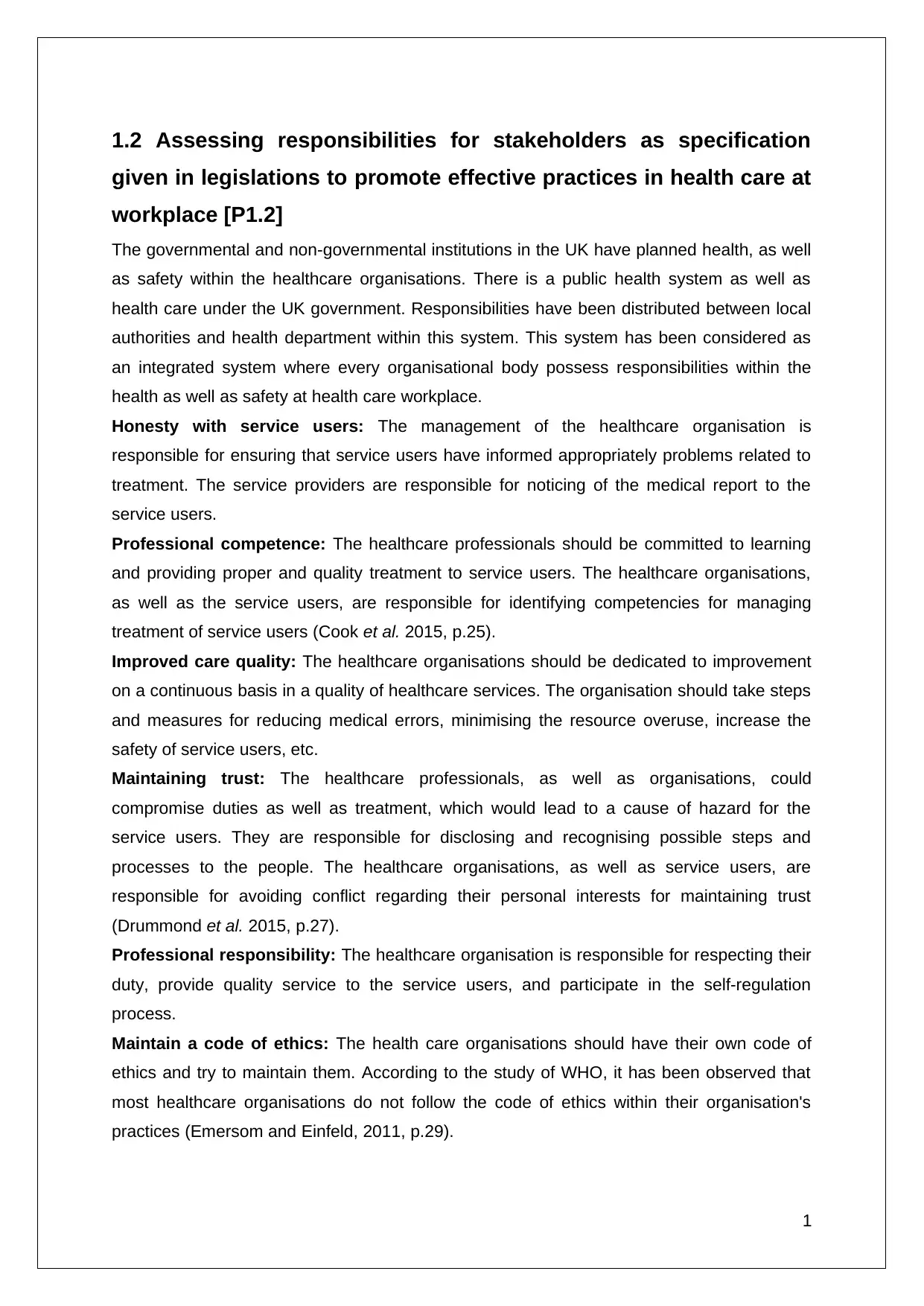
1.2 Assessing responsibilities for stakeholders as specification
given in legislations to promote effective practices in health care at
workplace [P1.2]
The governmental and non-governmental institutions in the UK have planned health, as well
as safety within the healthcare organisations. There is a public health system as well as
health care under the UK government. Responsibilities have been distributed between local
authorities and health department within this system. This system has been considered as
an integrated system where every organisational body possess responsibilities within the
health as well as safety at health care workplace.
Honesty with service users: The management of the healthcare organisation is
responsible for ensuring that service users have informed appropriately problems related to
treatment. The service providers are responsible for noticing of the medical report to the
service users.
Professional competence: The healthcare professionals should be committed to learning
and providing proper and quality treatment to service users. The healthcare organisations,
as well as the service users, are responsible for identifying competencies for managing
treatment of service users (Cook et al. 2015, p.25).
Improved care quality: The healthcare organisations should be dedicated to improvement
on a continuous basis in a quality of healthcare services. The organisation should take steps
and measures for reducing medical errors, minimising the resource overuse, increase the
safety of service users, etc.
Maintaining trust: The healthcare professionals, as well as organisations, could
compromise duties as well as treatment, which would lead to a cause of hazard for the
service users. They are responsible for disclosing and recognising possible steps and
processes to the people. The healthcare organisations, as well as service users, are
responsible for avoiding conflict regarding their personal interests for maintaining trust
(Drummond et al. 2015, p.27).
Professional responsibility: The healthcare organisation is responsible for respecting their
duty, provide quality service to the service users, and participate in the self-regulation
process.
Maintain a code of ethics: The health care organisations should have their own code of
ethics and try to maintain them. According to the study of WHO, it has been observed that
most healthcare organisations do not follow the code of ethics within their organisation's
practices (Emersom and Einfeld, 2011, p.29).
1
given in legislations to promote effective practices in health care at
workplace [P1.2]
The governmental and non-governmental institutions in the UK have planned health, as well
as safety within the healthcare organisations. There is a public health system as well as
health care under the UK government. Responsibilities have been distributed between local
authorities and health department within this system. This system has been considered as
an integrated system where every organisational body possess responsibilities within the
health as well as safety at health care workplace.
Honesty with service users: The management of the healthcare organisation is
responsible for ensuring that service users have informed appropriately problems related to
treatment. The service providers are responsible for noticing of the medical report to the
service users.
Professional competence: The healthcare professionals should be committed to learning
and providing proper and quality treatment to service users. The healthcare organisations,
as well as the service users, are responsible for identifying competencies for managing
treatment of service users (Cook et al. 2015, p.25).
Improved care quality: The healthcare organisations should be dedicated to improvement
on a continuous basis in a quality of healthcare services. The organisation should take steps
and measures for reducing medical errors, minimising the resource overuse, increase the
safety of service users, etc.
Maintaining trust: The healthcare professionals, as well as organisations, could
compromise duties as well as treatment, which would lead to a cause of hazard for the
service users. They are responsible for disclosing and recognising possible steps and
processes to the people. The healthcare organisations, as well as service users, are
responsible for avoiding conflict regarding their personal interests for maintaining trust
(Drummond et al. 2015, p.27).
Professional responsibility: The healthcare organisation is responsible for respecting their
duty, provide quality service to the service users, and participate in the self-regulation
process.
Maintain a code of ethics: The health care organisations should have their own code of
ethics and try to maintain them. According to the study of WHO, it has been observed that
most healthcare organisations do not follow the code of ethics within their organisation's
practices (Emersom and Einfeld, 2011, p.29).
1
⊘ This is a preview!⊘
Do you want full access?
Subscribe today to unlock all pages.

Trusted by 1+ million students worldwide
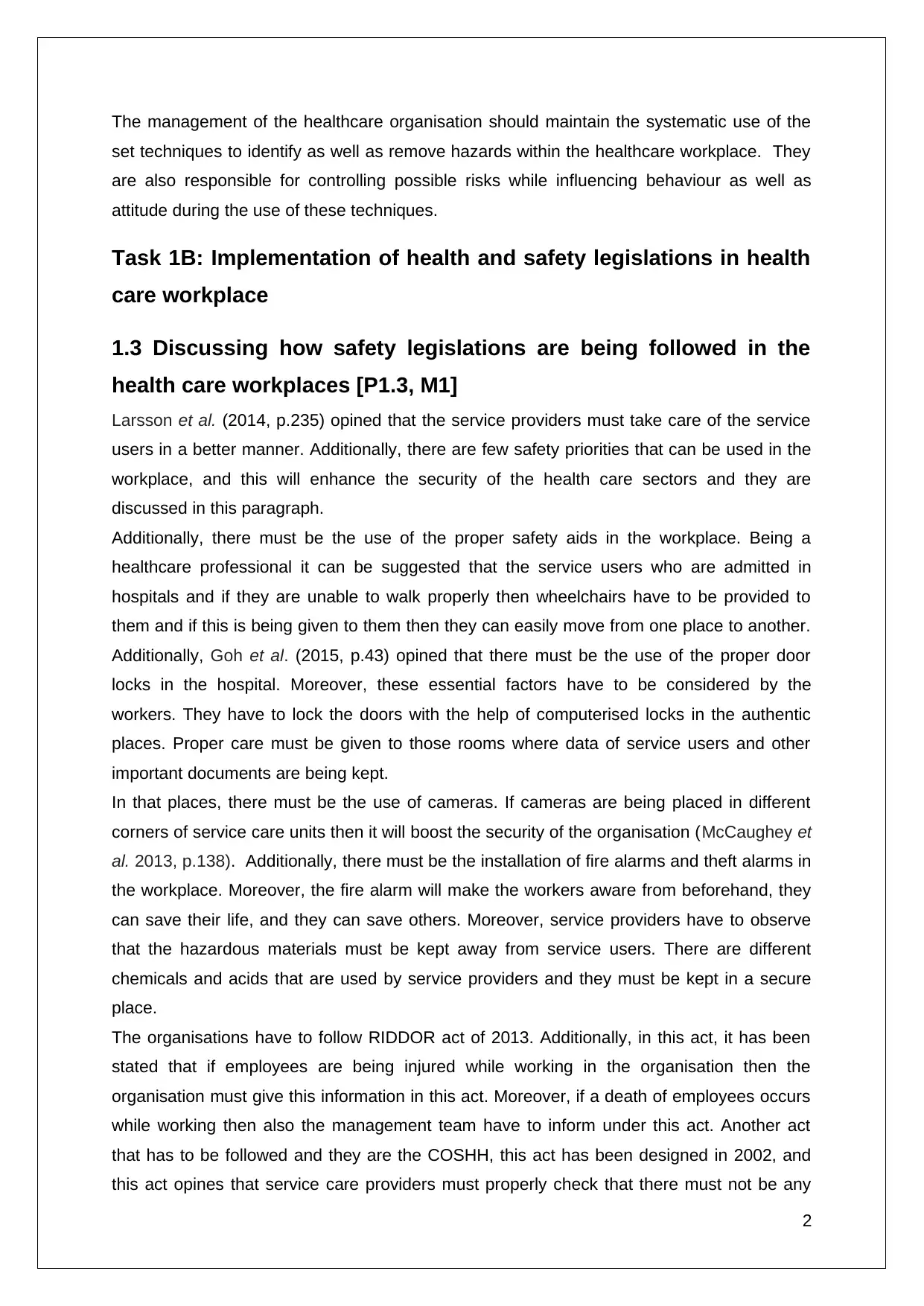
The management of the healthcare organisation should maintain the systematic use of the
set techniques to identify as well as remove hazards within the healthcare workplace. They
are also responsible for controlling possible risks while influencing behaviour as well as
attitude during the use of these techniques.
Task 1B: Implementation of health and safety legislations in health
care workplace
1.3 Discussing how safety legislations are being followed in the
health care workplaces [P1.3, M1]
Larsson et al. (2014, p.235) opined that the service providers must take care of the service
users in a better manner. Additionally, there are few safety priorities that can be used in the
workplace, and this will enhance the security of the health care sectors and they are
discussed in this paragraph.
Additionally, there must be the use of the proper safety aids in the workplace. Being a
healthcare professional it can be suggested that the service users who are admitted in
hospitals and if they are unable to walk properly then wheelchairs have to be provided to
them and if this is being given to them then they can easily move from one place to another.
Additionally, Goh et al. (2015, p.43) opined that there must be the use of the proper door
locks in the hospital. Moreover, these essential factors have to be considered by the
workers. They have to lock the doors with the help of computerised locks in the authentic
places. Proper care must be given to those rooms where data of service users and other
important documents are being kept.
In that places, there must be the use of cameras. If cameras are being placed in different
corners of service care units then it will boost the security of the organisation (McCaughey et
al. 2013, p.138). Additionally, there must be the installation of fire alarms and theft alarms in
the workplace. Moreover, the fire alarm will make the workers aware from beforehand, they
can save their life, and they can save others. Moreover, service providers have to observe
that the hazardous materials must be kept away from service users. There are different
chemicals and acids that are used by service providers and they must be kept in a secure
place.
The organisations have to follow RIDDOR act of 2013. Additionally, in this act, it has been
stated that if employees are being injured while working in the organisation then the
organisation must give this information in this act. Moreover, if a death of employees occurs
while working then also the management team have to inform under this act. Another act
that has to be followed and they are the COSHH, this act has been designed in 2002, and
this act opines that service care providers must properly check that there must not be any
2
set techniques to identify as well as remove hazards within the healthcare workplace. They
are also responsible for controlling possible risks while influencing behaviour as well as
attitude during the use of these techniques.
Task 1B: Implementation of health and safety legislations in health
care workplace
1.3 Discussing how safety legislations are being followed in the
health care workplaces [P1.3, M1]
Larsson et al. (2014, p.235) opined that the service providers must take care of the service
users in a better manner. Additionally, there are few safety priorities that can be used in the
workplace, and this will enhance the security of the health care sectors and they are
discussed in this paragraph.
Additionally, there must be the use of the proper safety aids in the workplace. Being a
healthcare professional it can be suggested that the service users who are admitted in
hospitals and if they are unable to walk properly then wheelchairs have to be provided to
them and if this is being given to them then they can easily move from one place to another.
Additionally, Goh et al. (2015, p.43) opined that there must be the use of the proper door
locks in the hospital. Moreover, these essential factors have to be considered by the
workers. They have to lock the doors with the help of computerised locks in the authentic
places. Proper care must be given to those rooms where data of service users and other
important documents are being kept.
In that places, there must be the use of cameras. If cameras are being placed in different
corners of service care units then it will boost the security of the organisation (McCaughey et
al. 2013, p.138). Additionally, there must be the installation of fire alarms and theft alarms in
the workplace. Moreover, the fire alarm will make the workers aware from beforehand, they
can save their life, and they can save others. Moreover, service providers have to observe
that the hazardous materials must be kept away from service users. There are different
chemicals and acids that are used by service providers and they must be kept in a secure
place.
The organisations have to follow RIDDOR act of 2013. Additionally, in this act, it has been
stated that if employees are being injured while working in the organisation then the
organisation must give this information in this act. Moreover, if a death of employees occurs
while working then also the management team have to inform under this act. Another act
that has to be followed and they are the COSHH, this act has been designed in 2002, and
this act opines that service care providers must properly check that there must not be any
2
Paraphrase This Document
Need a fresh take? Get an instant paraphrase of this document with our AI Paraphraser
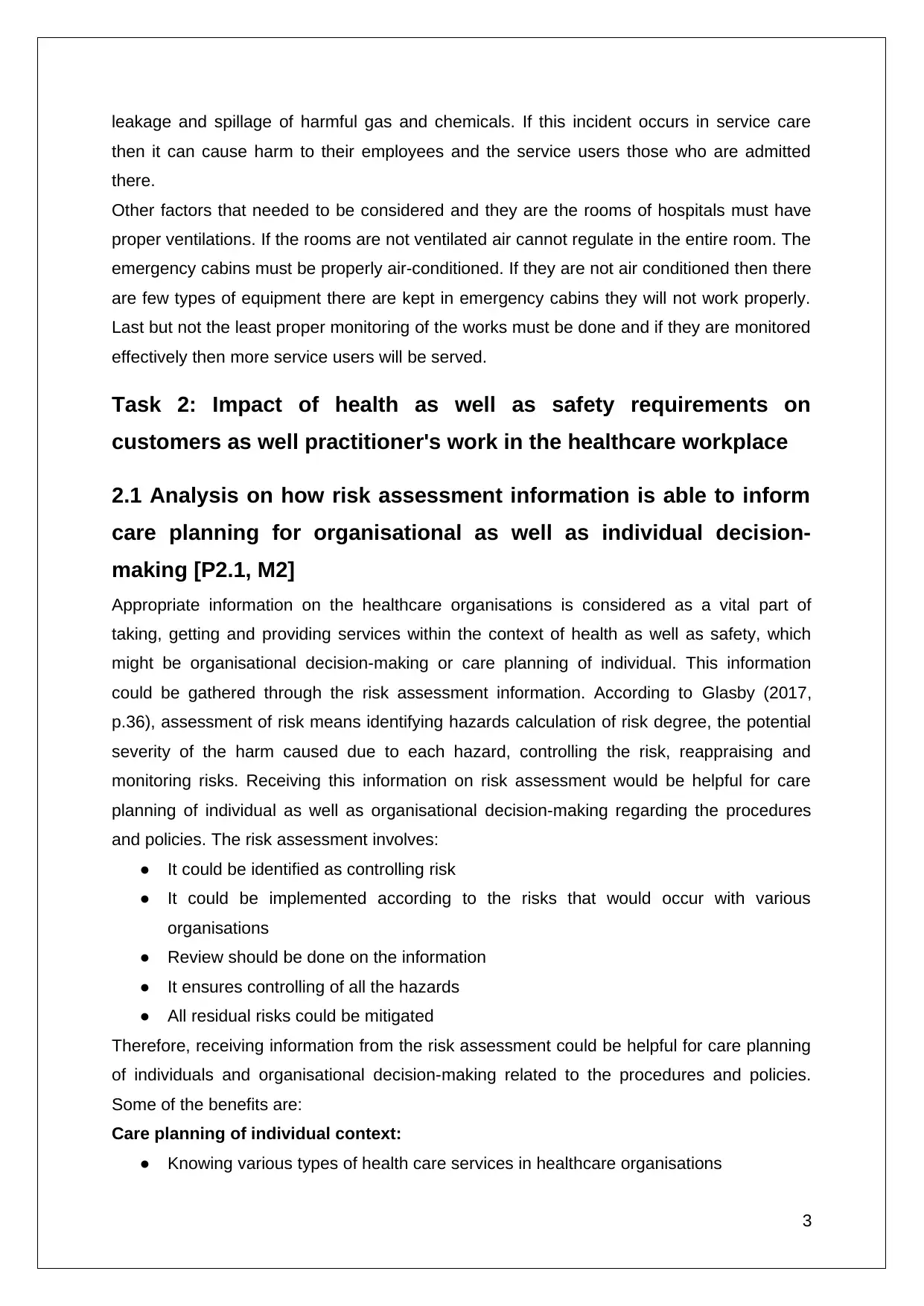
leakage and spillage of harmful gas and chemicals. If this incident occurs in service care
then it can cause harm to their employees and the service users those who are admitted
there.
Other factors that needed to be considered and they are the rooms of hospitals must have
proper ventilations. If the rooms are not ventilated air cannot regulate in the entire room. The
emergency cabins must be properly air-conditioned. If they are not air conditioned then there
are few types of equipment there are kept in emergency cabins they will not work properly.
Last but not the least proper monitoring of the works must be done and if they are monitored
effectively then more service users will be served.
Task 2: Impact of health as well as safety requirements on
customers as well practitioner's work in the healthcare workplace
2.1 Analysis on how risk assessment information is able to inform
care planning for organisational as well as individual decision-
making [P2.1, M2]
Appropriate information on the healthcare organisations is considered as a vital part of
taking, getting and providing services within the context of health as well as safety, which
might be organisational decision-making or care planning of individual. This information
could be gathered through the risk assessment information. According to Glasby (2017,
p.36), assessment of risk means identifying hazards calculation of risk degree, the potential
severity of the harm caused due to each hazard, controlling the risk, reappraising and
monitoring risks. Receiving this information on risk assessment would be helpful for care
planning of individual as well as organisational decision-making regarding the procedures
and policies. The risk assessment involves:
● It could be identified as controlling risk
● It could be implemented according to the risks that would occur with various
organisations
● Review should be done on the information
● It ensures controlling of all the hazards
● All residual risks could be mitigated
Therefore, receiving information from the risk assessment could be helpful for care planning
of individuals and organisational decision-making related to the procedures and policies.
Some of the benefits are:
Care planning of individual context:
● Knowing various types of health care services in healthcare organisations
3
then it can cause harm to their employees and the service users those who are admitted
there.
Other factors that needed to be considered and they are the rooms of hospitals must have
proper ventilations. If the rooms are not ventilated air cannot regulate in the entire room. The
emergency cabins must be properly air-conditioned. If they are not air conditioned then there
are few types of equipment there are kept in emergency cabins they will not work properly.
Last but not the least proper monitoring of the works must be done and if they are monitored
effectively then more service users will be served.
Task 2: Impact of health as well as safety requirements on
customers as well practitioner's work in the healthcare workplace
2.1 Analysis on how risk assessment information is able to inform
care planning for organisational as well as individual decision-
making [P2.1, M2]
Appropriate information on the healthcare organisations is considered as a vital part of
taking, getting and providing services within the context of health as well as safety, which
might be organisational decision-making or care planning of individual. This information
could be gathered through the risk assessment information. According to Glasby (2017,
p.36), assessment of risk means identifying hazards calculation of risk degree, the potential
severity of the harm caused due to each hazard, controlling the risk, reappraising and
monitoring risks. Receiving this information on risk assessment would be helpful for care
planning of individual as well as organisational decision-making regarding the procedures
and policies. The risk assessment involves:
● It could be identified as controlling risk
● It could be implemented according to the risks that would occur with various
organisations
● Review should be done on the information
● It ensures controlling of all the hazards
● All residual risks could be mitigated
Therefore, receiving information from the risk assessment could be helpful for care planning
of individuals and organisational decision-making related to the procedures and policies.
Some of the benefits are:
Care planning of individual context:
● Knowing various types of health care services in healthcare organisations
3
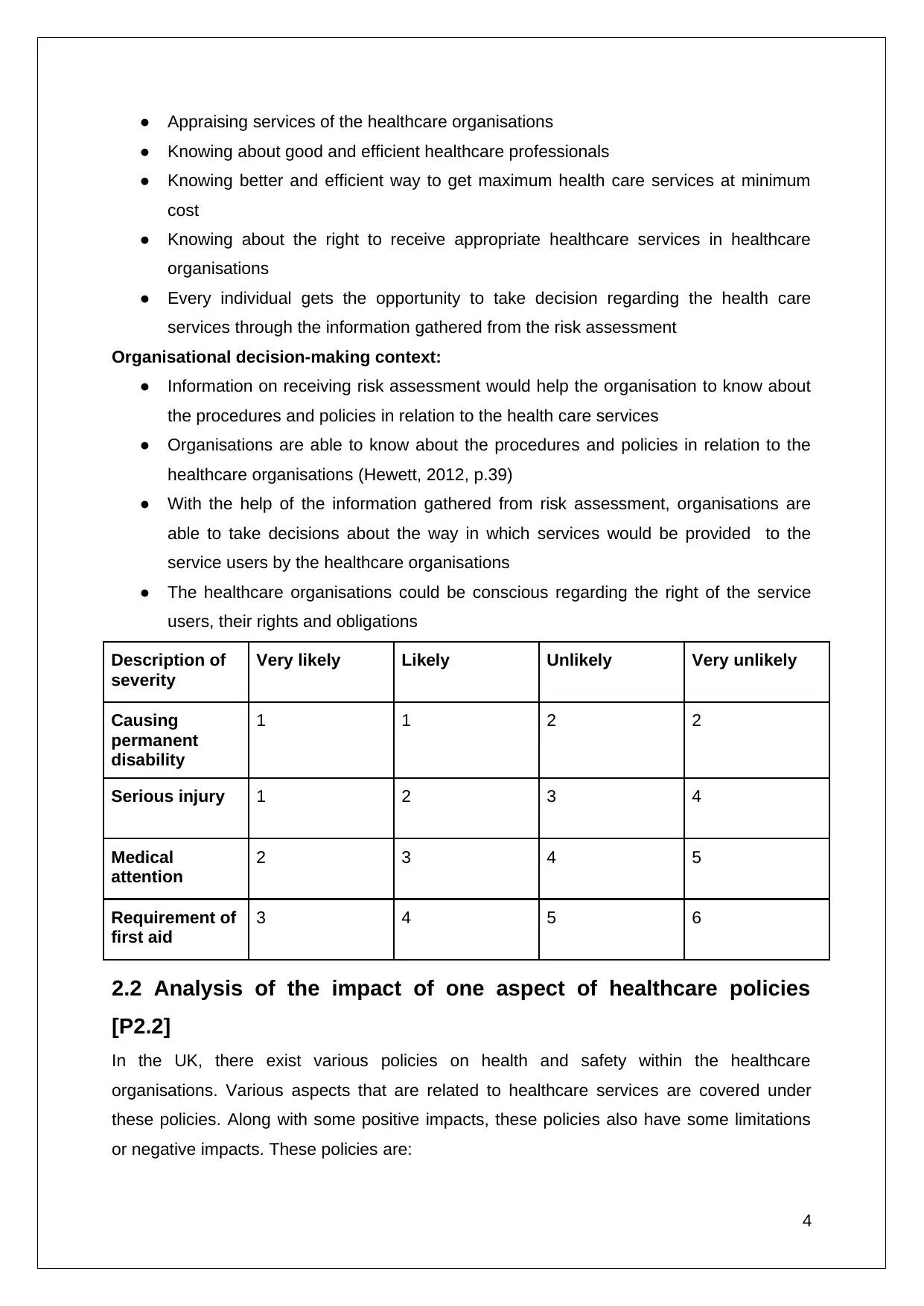
● Appraising services of the healthcare organisations
● Knowing about good and efficient healthcare professionals
● Knowing better and efficient way to get maximum health care services at minimum
cost
● Knowing about the right to receive appropriate healthcare services in healthcare
organisations
● Every individual gets the opportunity to take decision regarding the health care
services through the information gathered from the risk assessment
Organisational decision-making context:
● Information on receiving risk assessment would help the organisation to know about
the procedures and policies in relation to the health care services
● Organisations are able to know about the procedures and policies in relation to the
healthcare organisations (Hewett, 2012, p.39)
● With the help of the information gathered from risk assessment, organisations are
able to take decisions about the way in which services would be provided to the
service users by the healthcare organisations
● The healthcare organisations could be conscious regarding the right of the service
users, their rights and obligations
Description of
severity
Very likely Likely Unlikely Very unlikely
Causing
permanent
disability
1 1 2 2
Serious injury 1 2 3 4
Medical
attention
2 3 4 5
Requirement of
first aid
3 4 5 6
2.2 Analysis of the impact of one aspect of healthcare policies
[P2.2]
In the UK, there exist various policies on health and safety within the healthcare
organisations. Various aspects that are related to healthcare services are covered under
these policies. Along with some positive impacts, these policies also have some limitations
or negative impacts. These policies are:
4
● Knowing about good and efficient healthcare professionals
● Knowing better and efficient way to get maximum health care services at minimum
cost
● Knowing about the right to receive appropriate healthcare services in healthcare
organisations
● Every individual gets the opportunity to take decision regarding the health care
services through the information gathered from the risk assessment
Organisational decision-making context:
● Information on receiving risk assessment would help the organisation to know about
the procedures and policies in relation to the health care services
● Organisations are able to know about the procedures and policies in relation to the
healthcare organisations (Hewett, 2012, p.39)
● With the help of the information gathered from risk assessment, organisations are
able to take decisions about the way in which services would be provided to the
service users by the healthcare organisations
● The healthcare organisations could be conscious regarding the right of the service
users, their rights and obligations
Description of
severity
Very likely Likely Unlikely Very unlikely
Causing
permanent
disability
1 1 2 2
Serious injury 1 2 3 4
Medical
attention
2 3 4 5
Requirement of
first aid
3 4 5 6
2.2 Analysis of the impact of one aspect of healthcare policies
[P2.2]
In the UK, there exist various policies on health and safety within the healthcare
organisations. Various aspects that are related to healthcare services are covered under
these policies. Along with some positive impacts, these policies also have some limitations
or negative impacts. These policies are:
4
⊘ This is a preview!⊘
Do you want full access?
Subscribe today to unlock all pages.

Trusted by 1+ million students worldwide
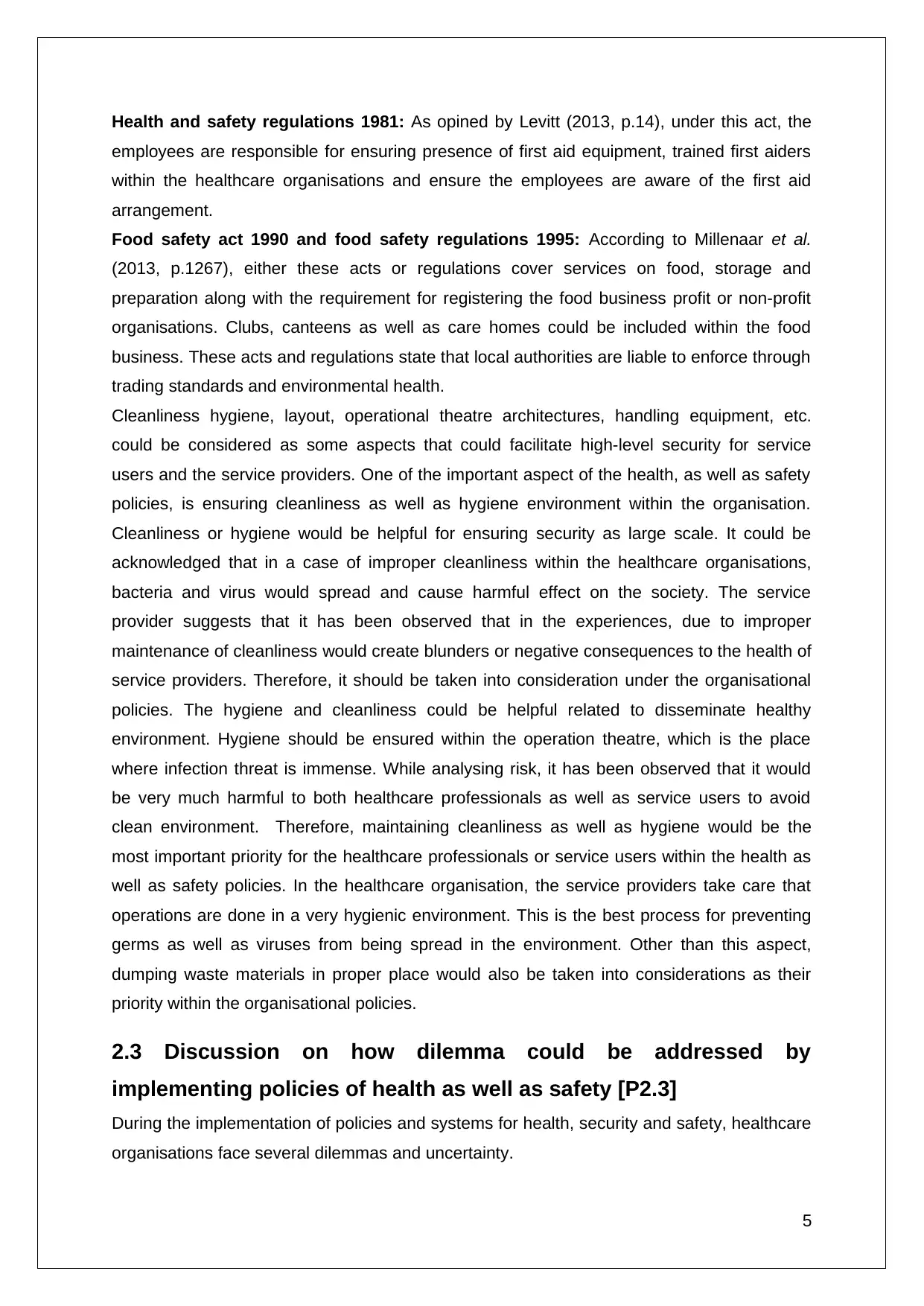
Health and safety regulations 1981: As opined by Levitt (2013, p.14), under this act, the
employees are responsible for ensuring presence of first aid equipment, trained first aiders
within the healthcare organisations and ensure the employees are aware of the first aid
arrangement.
Food safety act 1990 and food safety regulations 1995: According to Millenaar et al.
(2013, p.1267), either these acts or regulations cover services on food, storage and
preparation along with the requirement for registering the food business profit or non-profit
organisations. Clubs, canteens as well as care homes could be included within the food
business. These acts and regulations state that local authorities are liable to enforce through
trading standards and environmental health.
Cleanliness hygiene, layout, operational theatre architectures, handling equipment, etc.
could be considered as some aspects that could facilitate high-level security for service
users and the service providers. One of the important aspect of the health, as well as safety
policies, is ensuring cleanliness as well as hygiene environment within the organisation.
Cleanliness or hygiene would be helpful for ensuring security as large scale. It could be
acknowledged that in a case of improper cleanliness within the healthcare organisations,
bacteria and virus would spread and cause harmful effect on the society. The service
provider suggests that it has been observed that in the experiences, due to improper
maintenance of cleanliness would create blunders or negative consequences to the health of
service providers. Therefore, it should be taken into consideration under the organisational
policies. The hygiene and cleanliness could be helpful related to disseminate healthy
environment. Hygiene should be ensured within the operation theatre, which is the place
where infection threat is immense. While analysing risk, it has been observed that it would
be very much harmful to both healthcare professionals as well as service users to avoid
clean environment. Therefore, maintaining cleanliness as well as hygiene would be the
most important priority for the healthcare professionals or service users within the health as
well as safety policies. In the healthcare organisation, the service providers take care that
operations are done in a very hygienic environment. This is the best process for preventing
germs as well as viruses from being spread in the environment. Other than this aspect,
dumping waste materials in proper place would also be taken into considerations as their
priority within the organisational policies.
2.3 Discussion on how dilemma could be addressed by
implementing policies of health as well as safety [P2.3]
During the implementation of policies and systems for health, security and safety, healthcare
organisations face several dilemmas and uncertainty.
5
employees are responsible for ensuring presence of first aid equipment, trained first aiders
within the healthcare organisations and ensure the employees are aware of the first aid
arrangement.
Food safety act 1990 and food safety regulations 1995: According to Millenaar et al.
(2013, p.1267), either these acts or regulations cover services on food, storage and
preparation along with the requirement for registering the food business profit or non-profit
organisations. Clubs, canteens as well as care homes could be included within the food
business. These acts and regulations state that local authorities are liable to enforce through
trading standards and environmental health.
Cleanliness hygiene, layout, operational theatre architectures, handling equipment, etc.
could be considered as some aspects that could facilitate high-level security for service
users and the service providers. One of the important aspect of the health, as well as safety
policies, is ensuring cleanliness as well as hygiene environment within the organisation.
Cleanliness or hygiene would be helpful for ensuring security as large scale. It could be
acknowledged that in a case of improper cleanliness within the healthcare organisations,
bacteria and virus would spread and cause harmful effect on the society. The service
provider suggests that it has been observed that in the experiences, due to improper
maintenance of cleanliness would create blunders or negative consequences to the health of
service providers. Therefore, it should be taken into consideration under the organisational
policies. The hygiene and cleanliness could be helpful related to disseminate healthy
environment. Hygiene should be ensured within the operation theatre, which is the place
where infection threat is immense. While analysing risk, it has been observed that it would
be very much harmful to both healthcare professionals as well as service users to avoid
clean environment. Therefore, maintaining cleanliness as well as hygiene would be the
most important priority for the healthcare professionals or service users within the health as
well as safety policies. In the healthcare organisation, the service providers take care that
operations are done in a very hygienic environment. This is the best process for preventing
germs as well as viruses from being spread in the environment. Other than this aspect,
dumping waste materials in proper place would also be taken into considerations as their
priority within the organisational policies.
2.3 Discussion on how dilemma could be addressed by
implementing policies of health as well as safety [P2.3]
During the implementation of policies and systems for health, security and safety, healthcare
organisations face several dilemmas and uncertainty.
5
Paraphrase This Document
Need a fresh take? Get an instant paraphrase of this document with our AI Paraphraser
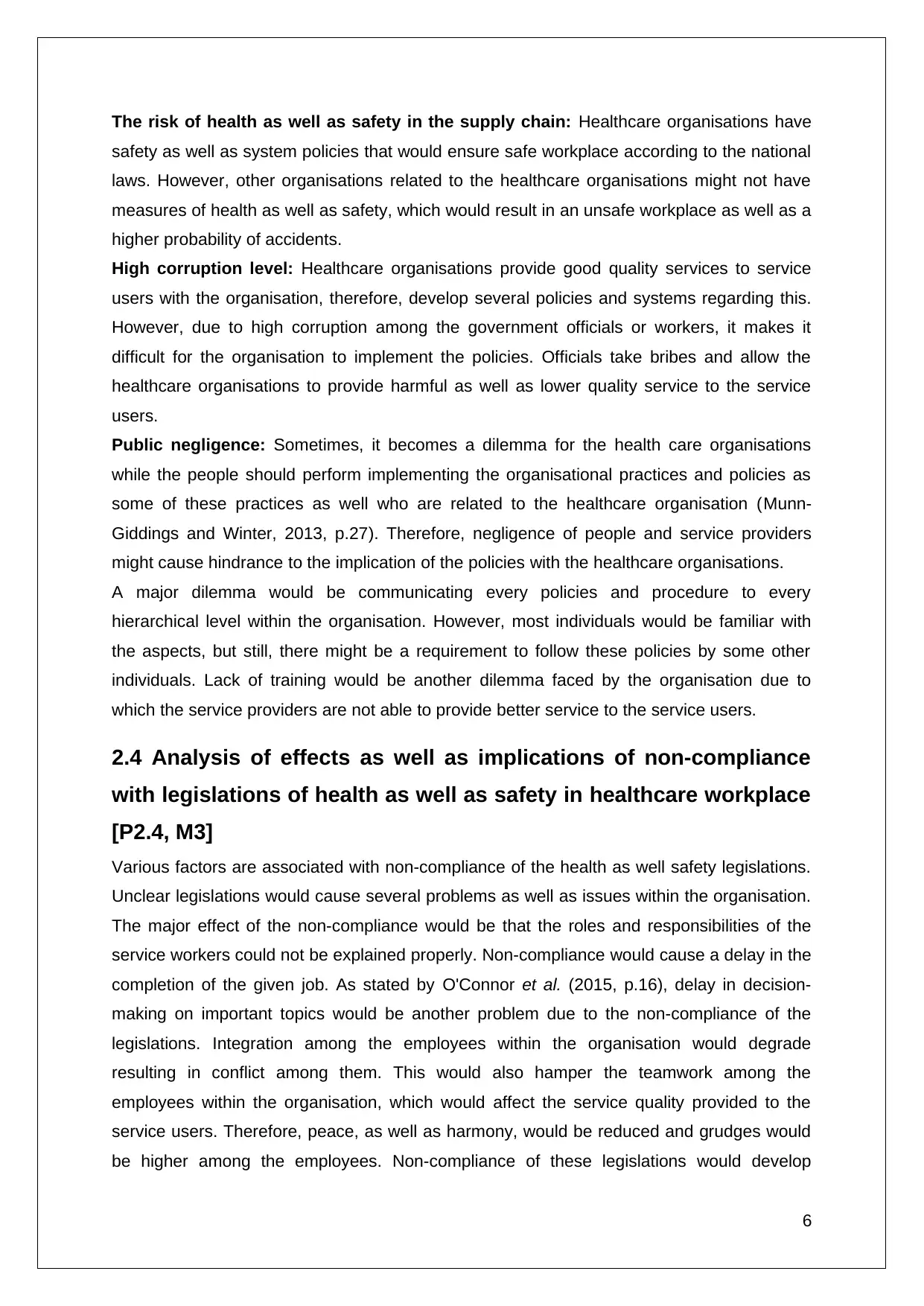
The risk of health as well as safety in the supply chain: Healthcare organisations have
safety as well as system policies that would ensure safe workplace according to the national
laws. However, other organisations related to the healthcare organisations might not have
measures of health as well as safety, which would result in an unsafe workplace as well as a
higher probability of accidents.
High corruption level: Healthcare organisations provide good quality services to service
users with the organisation, therefore, develop several policies and systems regarding this.
However, due to high corruption among the government officials or workers, it makes it
difficult for the organisation to implement the policies. Officials take bribes and allow the
healthcare organisations to provide harmful as well as lower quality service to the service
users.
Public negligence: Sometimes, it becomes a dilemma for the health care organisations
while the people should perform implementing the organisational practices and policies as
some of these practices as well who are related to the healthcare organisation (Munn-
Giddings and Winter, 2013, p.27). Therefore, negligence of people and service providers
might cause hindrance to the implication of the policies with the healthcare organisations.
A major dilemma would be communicating every policies and procedure to every
hierarchical level within the organisation. However, most individuals would be familiar with
the aspects, but still, there might be a requirement to follow these policies by some other
individuals. Lack of training would be another dilemma faced by the organisation due to
which the service providers are not able to provide better service to the service users.
2.4 Analysis of effects as well as implications of non-compliance
with legislations of health as well as safety in healthcare workplace
[P2.4, M3]
Various factors are associated with non-compliance of the health as well safety legislations.
Unclear legislations would cause several problems as well as issues within the organisation.
The major effect of the non-compliance would be that the roles and responsibilities of the
service workers could not be explained properly. Non-compliance would cause a delay in the
completion of the given job. As stated by O'Connor et al. (2015, p.16), delay in decision-
making on important topics would be another problem due to the non-compliance of the
legislations. Integration among the employees within the organisation would degrade
resulting in conflict among them. This would also hamper the teamwork among the
employees within the organisation, which would affect the service quality provided to the
service users. Therefore, peace, as well as harmony, would be reduced and grudges would
be higher among the employees. Non-compliance of these legislations would develop
6
safety as well as system policies that would ensure safe workplace according to the national
laws. However, other organisations related to the healthcare organisations might not have
measures of health as well as safety, which would result in an unsafe workplace as well as a
higher probability of accidents.
High corruption level: Healthcare organisations provide good quality services to service
users with the organisation, therefore, develop several policies and systems regarding this.
However, due to high corruption among the government officials or workers, it makes it
difficult for the organisation to implement the policies. Officials take bribes and allow the
healthcare organisations to provide harmful as well as lower quality service to the service
users.
Public negligence: Sometimes, it becomes a dilemma for the health care organisations
while the people should perform implementing the organisational practices and policies as
some of these practices as well who are related to the healthcare organisation (Munn-
Giddings and Winter, 2013, p.27). Therefore, negligence of people and service providers
might cause hindrance to the implication of the policies with the healthcare organisations.
A major dilemma would be communicating every policies and procedure to every
hierarchical level within the organisation. However, most individuals would be familiar with
the aspects, but still, there might be a requirement to follow these policies by some other
individuals. Lack of training would be another dilemma faced by the organisation due to
which the service providers are not able to provide better service to the service users.
2.4 Analysis of effects as well as implications of non-compliance
with legislations of health as well as safety in healthcare workplace
[P2.4, M3]
Various factors are associated with non-compliance of the health as well safety legislations.
Unclear legislations would cause several problems as well as issues within the organisation.
The major effect of the non-compliance would be that the roles and responsibilities of the
service workers could not be explained properly. Non-compliance would cause a delay in the
completion of the given job. As stated by O'Connor et al. (2015, p.16), delay in decision-
making on important topics would be another problem due to the non-compliance of the
legislations. Integration among the employees within the organisation would degrade
resulting in conflict among them. This would also hamper the teamwork among the
employees within the organisation, which would affect the service quality provided to the
service users. Therefore, peace, as well as harmony, would be reduced and grudges would
be higher among the employees. Non-compliance of these legislations would develop
6
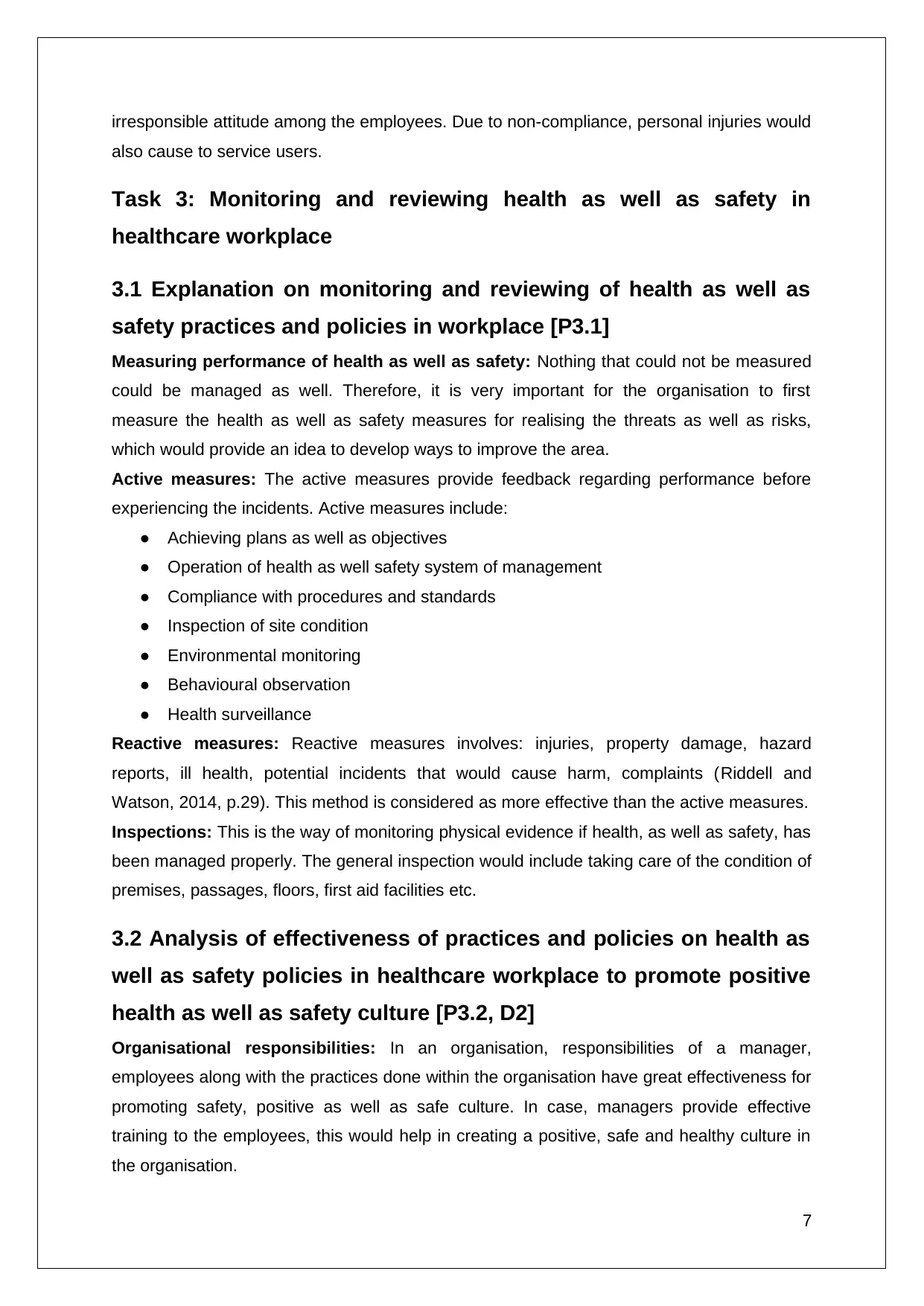
irresponsible attitude among the employees. Due to non-compliance, personal injuries would
also cause to service users.
Task 3: Monitoring and reviewing health as well as safety in
healthcare workplace
3.1 Explanation on monitoring and reviewing of health as well as
safety practices and policies in workplace [P3.1]
Measuring performance of health as well as safety: Nothing that could not be measured
could be managed as well. Therefore, it is very important for the organisation to first
measure the health as well as safety measures for realising the threats as well as risks,
which would provide an idea to develop ways to improve the area.
Active measures: The active measures provide feedback regarding performance before
experiencing the incidents. Active measures include:
● Achieving plans as well as objectives
● Operation of health as well safety system of management
● Compliance with procedures and standards
● Inspection of site condition
● Environmental monitoring
● Behavioural observation
● Health surveillance
Reactive measures: Reactive measures involves: injuries, property damage, hazard
reports, ill health, potential incidents that would cause harm, complaints (Riddell and
Watson, 2014, p.29). This method is considered as more effective than the active measures.
Inspections: This is the way of monitoring physical evidence if health, as well as safety, has
been managed properly. The general inspection would include taking care of the condition of
premises, passages, floors, first aid facilities etc.
3.2 Analysis of effectiveness of practices and policies on health as
well as safety policies in healthcare workplace to promote positive
health as well as safety culture [P3.2, D2]
Organisational responsibilities: In an organisation, responsibilities of a manager,
employees along with the practices done within the organisation have great effectiveness for
promoting safety, positive as well as safe culture. In case, managers provide effective
training to the employees, this would help in creating a positive, safe and healthy culture in
the organisation.
7
also cause to service users.
Task 3: Monitoring and reviewing health as well as safety in
healthcare workplace
3.1 Explanation on monitoring and reviewing of health as well as
safety practices and policies in workplace [P3.1]
Measuring performance of health as well as safety: Nothing that could not be measured
could be managed as well. Therefore, it is very important for the organisation to first
measure the health as well as safety measures for realising the threats as well as risks,
which would provide an idea to develop ways to improve the area.
Active measures: The active measures provide feedback regarding performance before
experiencing the incidents. Active measures include:
● Achieving plans as well as objectives
● Operation of health as well safety system of management
● Compliance with procedures and standards
● Inspection of site condition
● Environmental monitoring
● Behavioural observation
● Health surveillance
Reactive measures: Reactive measures involves: injuries, property damage, hazard
reports, ill health, potential incidents that would cause harm, complaints (Riddell and
Watson, 2014, p.29). This method is considered as more effective than the active measures.
Inspections: This is the way of monitoring physical evidence if health, as well as safety, has
been managed properly. The general inspection would include taking care of the condition of
premises, passages, floors, first aid facilities etc.
3.2 Analysis of effectiveness of practices and policies on health as
well as safety policies in healthcare workplace to promote positive
health as well as safety culture [P3.2, D2]
Organisational responsibilities: In an organisation, responsibilities of a manager,
employees along with the practices done within the organisation have great effectiveness for
promoting safety, positive as well as safe culture. In case, managers provide effective
training to the employees, this would help in creating a positive, safe and healthy culture in
the organisation.
7
⊘ This is a preview!⊘
Do you want full access?
Subscribe today to unlock all pages.

Trusted by 1+ million students worldwide
1 out of 15
Related Documents
Your All-in-One AI-Powered Toolkit for Academic Success.
+13062052269
info@desklib.com
Available 24*7 on WhatsApp / Email
![[object Object]](/_next/static/media/star-bottom.7253800d.svg)
Unlock your academic potential
Copyright © 2020–2025 A2Z Services. All Rights Reserved. Developed and managed by ZUCOL.




